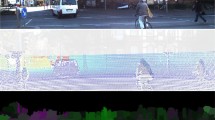
Overview
- Provides novel Bayesian models for complex environment perception problems
- Describes spatial and temporal extensions of widely used probabilistic inference methods
- Provides real-world application examples for the introduced theoretical results
Access this book
Tax calculation will be finalised at checkout
Other ways to access
About this book
This book deals with selected problems of machine perception, using various 2D and 3D imaging sensors. It proposes several new original methods, and also provides a detailed state-of-the-art overview of existing techniques for automated, multi-level interpretation of the observed static or dynamic environment. To ensure a sound theoretical basis of the new models, the surveys and algorithmic developments are performed in well-established Bayesian frameworks. Low level scene understanding functions are formulated as various image segmentation problems, where the advantages of probabilistic inference techniques such as Markov Random Fields (MRF) or Mixed Markov Models are considered. For the object level scene analysis, the book mainly relies on the literature of Marked Point Process (MPP) approaches, which consider strong geometric and prior interaction constraints in object population modeling. In particular, key developments are introduced in the spatial hierarchical decomposition of the observed scenarios, and in the temporal extension of complex MRF and MPP models. Apart from utilizing conventional optical sensors, case studies are provided on passive radar (ISAR) and Lidar-based Bayesian environment perception tasks. It is shown, via several experiments, that the proposed contributions embedded into a strict mathematical toolkit can significantly improve the results in real world 2D/3D test images and videos, for applications in video surveillance, smart city monitoring, autonomous driving, remote sensing, and optical industrial inspection.
Similar content being viewed by others
Keywords
Table of contents (7 chapters)
Authors and Affiliations
About the author
Bibliographic Information
Book Title: Multi-Level Bayesian Models for Environment Perception
Authors: Csaba Benedek
DOI: https://doi.org/10.1007/978-3-030-83654-2
Publisher: Springer Cham
eBook Packages: Mathematics and Statistics, Mathematics and Statistics (R0)
Copyright Information: The Editor(s) (if applicable) and The Author(s), under exclusive license to Springer Nature Switzerland AG 2022
Hardcover ISBN: 978-3-030-83653-5Published: 19 April 2022
Softcover ISBN: 978-3-030-83656-6Published: 20 April 2023
eBook ISBN: 978-3-030-83654-2Published: 18 April 2022
Edition Number: 1
Number of Pages: XIII, 202
Number of Illustrations: 31 b/w illustrations, 70 illustrations in colour
Topics: Bayesian Inference, Image Processing and Computer Vision, Probability Theory and Stochastic Processes, Statistics and Computing/Statistics Programs, Statistical Theory and Methods



